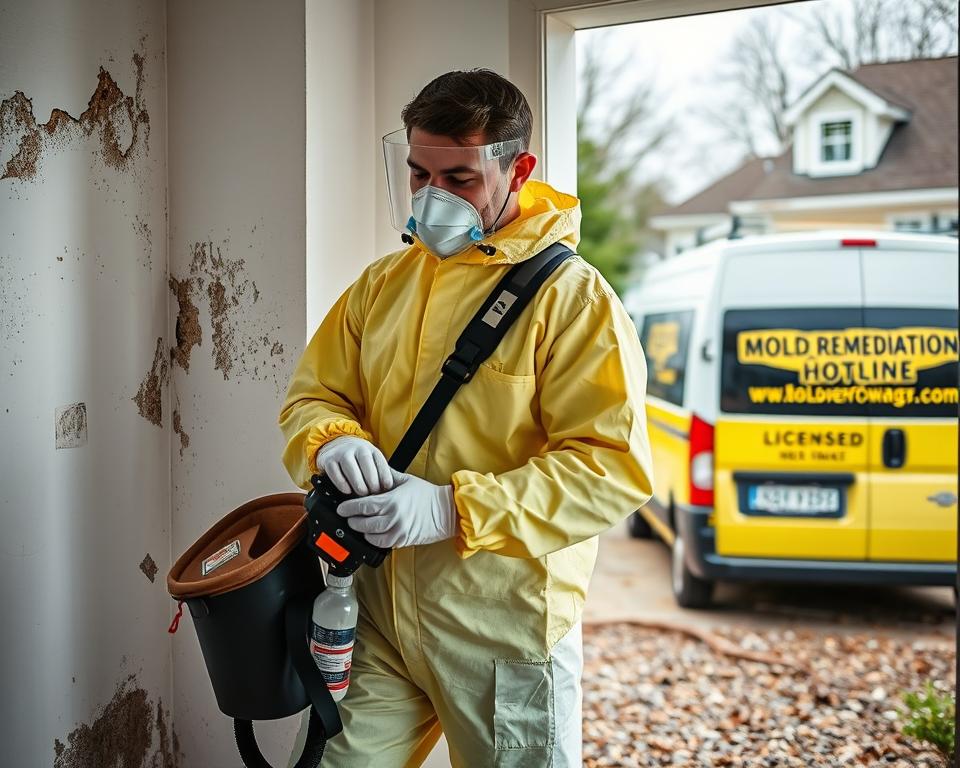What if your home is hiding a silent threat you can’t see? Unchecked moisture or leaks can lead to rapid mold growth, putting your property and health at risk. Acting fast is critical to prevent costly repairs. That’s where certified professionals step in, offering 24/7 solutions to tackle these issues head-on.
Teams like SERVPRO® use advanced detection tools to locate hidden growth, even behind walls or under floors. Their rapid response minimizes disruption, stopping spores from spreading further. Every hour counts—delaying action allows damage to escalate, compromising air quality and structural safety.
Whether you spot visible patches or suspect hidden infestations, professional help ensures thorough removal. Trusting experts with proper training guarantees your space is restored safely and efficiently. Don’t wait until it’s too late—address the problem before it worsens.
Key Takeaways
- Immediate action prevents mold from spreading and causing irreversible damage.
- Certified technicians use advanced tools to detect hidden growth areas.
- 24/7 availability ensures rapid response to mitigate risks.
- Professional services minimize disruption during cleanup.
- Ignoring small leaks or moisture can lead to major infestations.
Understanding Mold Risks and Emergency Protocols
Mold thrives in environments you might least expect, silently compromising your space. Left unchecked, it can damage structures and trigger health concerns. Recognizing early signs and acting swiftly reduces long-term risks.
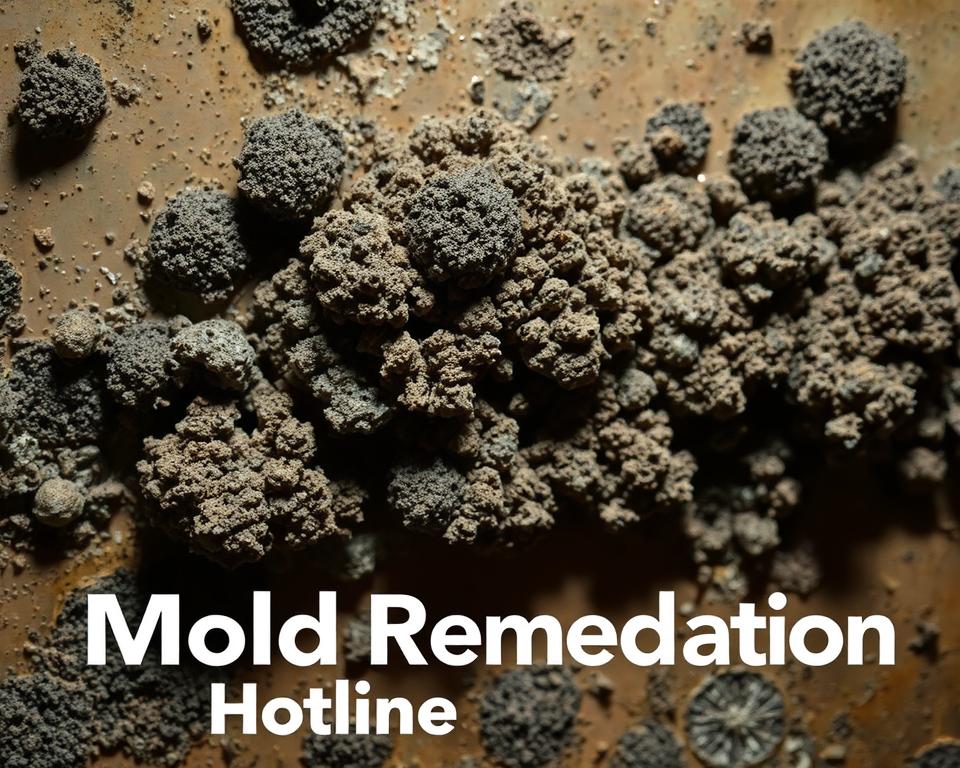
Common Causes and Warning Signs
Mold spores multiply rapidly when exposed to moisture. Common triggers include:
- Leaky pipes or roof damage
- Poor ventilation in bathrooms or basements
- Flooding from storms or appliance failures
Musty odors or warped drywall often signal hidden growth. Discoloration on walls or ceilings—green, black, or gray patches—demands immediate attention. The EPA warns that “mold can spread within 48 hours of water exposure”, making quick action essential.
Health Implications of Mold Exposure
Breathing contaminated air can worsen allergies and asthma. Sensitive individuals may experience:
- Persistent coughing or sneezing
- Skin irritation
- Fatigue and headaches
Children and older adults face higher risks. Professional remediation services use HEPA filters to trap spores during cleanup, improving indoor air quality. Thermal imaging tools also help detect hidden growth behind walls, ensuring thorough removal.
Delaying repairs allows spores to spread, escalating restoration costs. Regular property inspections identify vulnerabilities before they become crises. Trust certified teams to handle containment and cleaning—your health depends on it.
Licensed Emergency Mold Remediation Near Me
Professional intervention is key to effective mold management. Certified teams bring precision tools and structured methods that untrained individuals lack. Their approach safeguards both property value and occupant well-being.
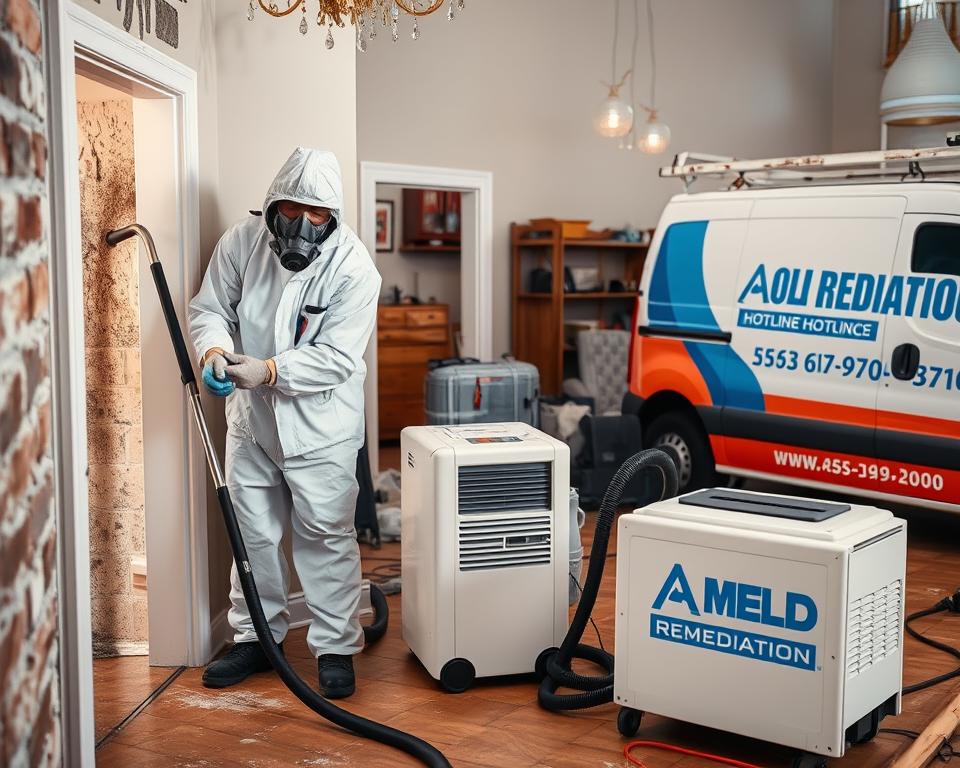
Why Choose Professional Services?
Proper credentials ensure technicians follow industry standards. For example, SERVPRO® employs IICRC-certified specialists trained in containment strategies. This prevents spores from spreading to unaffected areas during cleanup.
Established providers use a clear remediation process starting with an initial assessment. Advanced equipment like infrared cameras identifies moisture sources invisible to the naked eye. Fast response times—often within hours—limit damage escalation.
Experts also address client questions about safety protocols or timelines. Their evaluations include air quality testing to ensure spores don’t linger post-cleanup. By reducing cross-contamination risks, they preserve indoor air integrity.
- Licensing guarantees adherence to EPA guidelines
- Step-by-step removal minimizes recurrence
- 24/7 availability stops minor issues from becoming disasters
A timely call to certified professionals ensures your space returns to safe conditions efficiently. Their systematic methods protect your investment while prioritizing health.
Our Expert Mold Remediation Services
Expert techniques transform hazardous environments into safe spaces. Specialized teams combine cutting-edge tools with proven strategies to address contamination at its source. This systematic approach ensures lasting results while protecting occupants and structures.
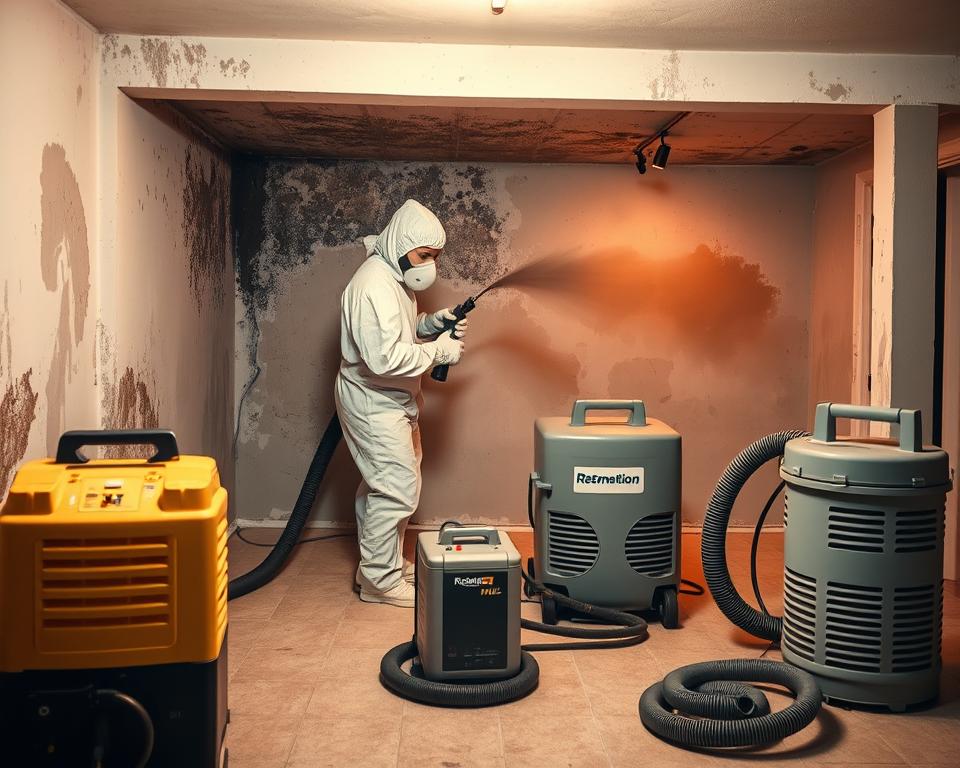
Mold Removal Process Overview
Certified professionals follow a rigorous five-step method. It begins with a detailed property assessment using infrared cameras to locate moisture pockets. SERVPRO® technicians then isolate affected zones with physical barriers to prevent spore spread.
Next, air scrubbers with HEPA filters capture airborne particles. Antifungal treatments target colonies on surfaces, while specialized vacuums remove debris. Finally, post-cleanup air testing verifies indoor air quality meets safety standards.
Advanced Equipment and Techniques
Modern tools enable precise, efficient cleanup. Key technologies include:
- Moisture meters detecting hidden dampness in walls
- Thermal imaging cameras mapping temperature variations
- Commercial-grade dehumidifiers drying structures rapidly
Certified Restoration reports these methods reduce cleanup time by 40% compared to DIY approaches. Antimicrobial coatings also inhibit future growth in vulnerable areas.
Residential and Commercial Solutions
Strategies vary based on property size and usage. Residential projects focus on minimizing family displacement, while commercial jobs prioritize business continuity. See how solutions differ:
| Aspect | Homes | Businesses |
|---|---|---|
| Containment | Single-room barriers | Multi-zone partitions |
| Equipment | Portable units | Industrial systems |
| Timeline | 24-72 hours | 5-10 days |
Both services include restoration work like drywall replacement or flooring repairs. Professionals tailor their process to restore properties fully, whether tackling a basement or office complex.
Emergency Response and Rapid Remediation
When hidden moisture strikes, every minute counts. SERVPRO® warns, “Mold colonies can multiply exponentially within 24-72 hours of water exposure.” This rapid growth demands immediate action to prevent structural weakening and health hazards.
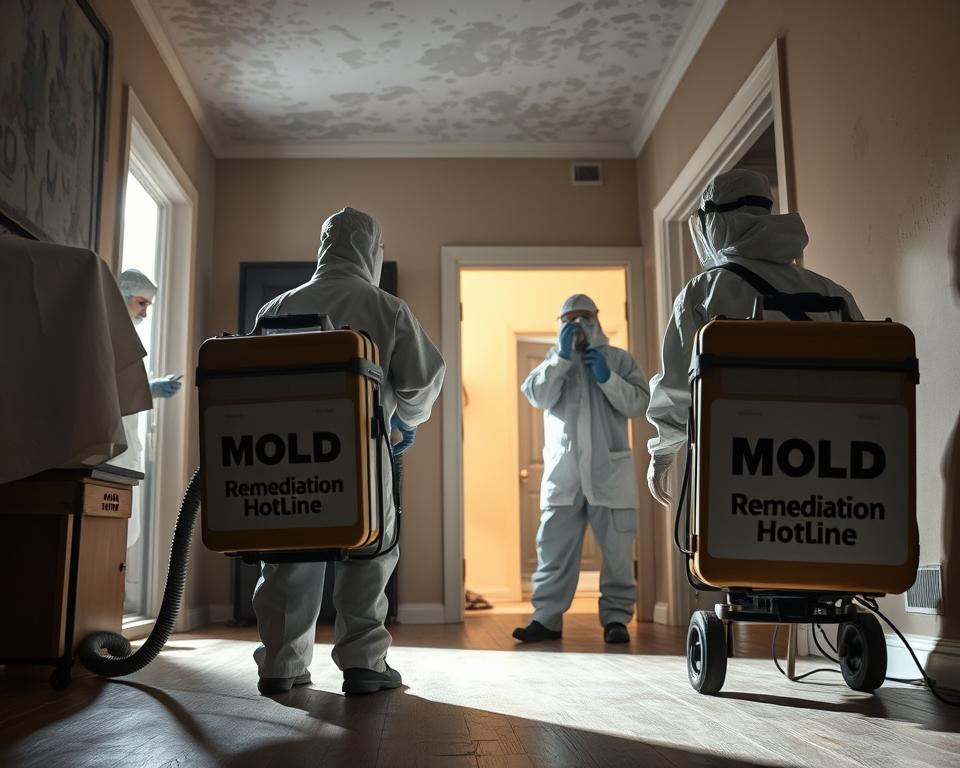
24/7 emergency services are critical during these crises. Certified teams arrive within hours to assess the situation, using moisture meters and thermal imaging to locate hidden issues. Their priority? Containing spores before they infiltrate unaffected areas.
Here’s how rapid remediation works:
- Initial inspection identifies contamination sources
- Containment barriers halt spore spread
- HEPA air scrubbers purify indoor environments
- Antimicrobial treatments eliminate colonies
Delaying a professional call risks escalating repair costs. Early intervention simplifies insurance claims by documenting damage origins clearly. Teams also secure affected areas to protect belongings during cleanup.
If you notice musty odors or discolored walls, act today. Specialists streamline the process—from assessment to restoration—ensuring your space returns to safe conditions swiftly. Trust experts to minimize disruption while safeguarding your property’s future.
Mold Containment and Air Filtration Techniques
Controlling mold requires precision to prevent invisible threats from spreading. Specialized strategies isolate affected zones while advanced systems purify the air. This dual approach stops contamination and protects unaffected areas.
Effective Containment Strategies
Certified teams begin by shutting off HVAC systems to avoid circulating spores. Physical barriers made of plastic sheeting seal contaminated areas. Negative air pressure machines keep particles from escaping through gaps.
Workers wear protective gear to avoid cross-contamination. SERVPRO® emphasizes that “containment is useless without proper sealing of entry points”. This step-by-step isolation ensures spores stay confined during removal.
HEPA Filtration and Air Quality Improvement
Air scrubbers with HEPA filters capture 99.97% of particles as small as 0.3 microns. These devices run continuously to clean the air during cleanup. Technicians avoid standard fans, which could spread spores through airflow.
| Equipment | Purpose | Benefit |
|---|---|---|
| HEPA Air Scrubbers | Remove airborne particles | Improve breathing safety |
| Negative Air Machines | Maintain containment pressure | Prevent spore migration |
| Antimicrobial Sprayers | Disinfect surfaces | Stop regrowth |
Post-cleanup tests verify air quality meets OSHA standards. Combining containment with filtration creates a safer environment for occupants and workers. These methods ensure long-term protection against recurring issues.
Advanced Mold Inspection and Damage Assessment
Accurate diagnosis forms the backbone of effective mold management. Certified teams like SERVPRO® and Certified Restoration use systematic approaches to evaluate contamination scope. Their process combines visual checks with cutting-edge technology, ensuring no growth goes unnoticed.
Visual Inspection Methods
Technicians start by examining walls, ceilings, and HVAC systems for discoloration or warping. Infrared cameras detect temperature variations behind surfaces—key indicators of hidden moisture. For commercial properties, inspectors check ventilation ducts and storage areas prone to dampness.
Portable moisture meters measure humidity levels in drywall or insulation. These tools help pinpoint colonies invisible to the naked eye. Residential assessments often focus on basements and bathrooms, while commercial mold inspections prioritize large-scale plumbing networks.
Identifying Hidden Water Sources
Persistent leaks often stem from cracked pipes or faulty seals. Thermal imaging locates condensation buildup within walls, while hygrometers track ambient humidity. SERVPRO® notes, “60% of water sources in buildings remain undetected without professional tools.”
Technicians trace plumbing lines and roof seams to find entry points. In damage restoration cases, they prioritize fixing these issues before removal begins. This prevents recurring growth and protects property integrity long-term.
| Tool | Purpose | Use Case |
|---|---|---|
| Thermal Camera | Find moisture pockets | Behind walls |
| Hygrometer | Measure humidity | Air quality checks |
| Borescope | Inspect tight spaces | Inside ducts |
Post-inspection, teams create tailored plans addressing mold damage severity. Timely action reduces removal costs and safeguards indoor environments. Trust experts to turn risky spaces into safe zones through precision assessment.
Insurance and Claims: Making the Process Easier
Navigating insurance after discovering mold damage often feels overwhelming. Homeowners and business owners face complex paperwork, unclear coverage terms, and delays that prolong stress. Professional mold remediation services bridge this gap by handling the heavy lifting.
Streamlined Claims Process
Certified teams like SERVPRO® simplify claims by working directly with insurers. They document damage thoroughly, providing photos and moisture readings that validate claims. This evidence speeds up approvals, reducing disputes over coverage.
Technicians manage all communication with adjusters, saving clients hours of phone calls. “Our job is to turn chaos into clarity,” notes a SERVPRO® project manager. Their established relationships with major insurance companies ensure smoother negotiations.
Here’s how it works:
- Initial assessment creates a detailed damage report
- Experts submit documentation to insurers promptly
- Restoration begins while claims are processed
This approach minimizes out-of-pocket costs and accelerates property restoration. Clients avoid common pitfalls like incomplete forms or missed deadlines. With professionals guiding each step, recovery becomes faster and less stressful.
Property Restoration and Long-Term Solutions
After mold removal, properties need more than surface-level fixes. Comprehensive restoration ensures spaces return to safe, functional conditions while preventing future issues. This phase focuses on structural integrity and aesthetic recovery, creating lasting value for homeowners and businesses.
Restoration and Rebuilding Methods
Certified teams use tailored approaches based on damage severity. Minor repairs might involve drywall patching or flooring spot treatments. For extensive cases, full wall replacements or subfloor reconstruction become necessary. SERVPRO® emphasizes, “Restoration isn’t just about repairs—it’s about rebuilding trust in your space.”
Cleaning plays a vital role post-rebuild. Professionals sanitize surfaces with antimicrobial solutions and replace insulation to eliminate lingering spores. Final touches like paint matching or trim installation restore visual harmony.
| Method | Application | Benefit |
|---|---|---|
| Drywall Replacement | Water-damaged walls | Prevents warping |
| Flooring Installation | Rotting subfloors | Restores stability |
| Structural Reinforcement | Weakened beams | Enhances safety |
Ongoing contact with clients ensures transparency during multi-phase projects. Teams provide timelines and answer questions about material choices or permit requirements. Many include warranties to guarantee work quality.
Long-term solutions like moisture barriers or improved ventilation protect against recurring damage. These steps maintain property value while ensuring occupants enjoy healthy environments for years.
Conclusion
Protecting your space from mold damage demands swift, strategic action. Certified professionals follow a proven remediation process—detecting hidden growth, containing spores, and restoring air quality with industrial-grade equipment. Delaying response allows colonies to spread, risking structural harm and health complications.
Acting today prevents long-term issues. Advanced tools like infrared cameras pinpoint moisture sources, while HEPA filtration systems capture 99.97% of particles. This approach minimizes disruption to homes or businesses and stops cross-contamination.
Trusting experts ensures thorough removal and lasting solutions. Their methods address visible patches and hidden infestations alike, safeguarding your property’s value. Whether handling residential basements or commercial complexes, tailored strategies prioritize safety at every step.
Don’t let uncertainty put your health at risk—certified teams are ready to restore your space safely. Call today for a detailed assessment and reclaim your environment from stubborn growth. Reach out now to start the journey toward cleaner air and peace of mind.
